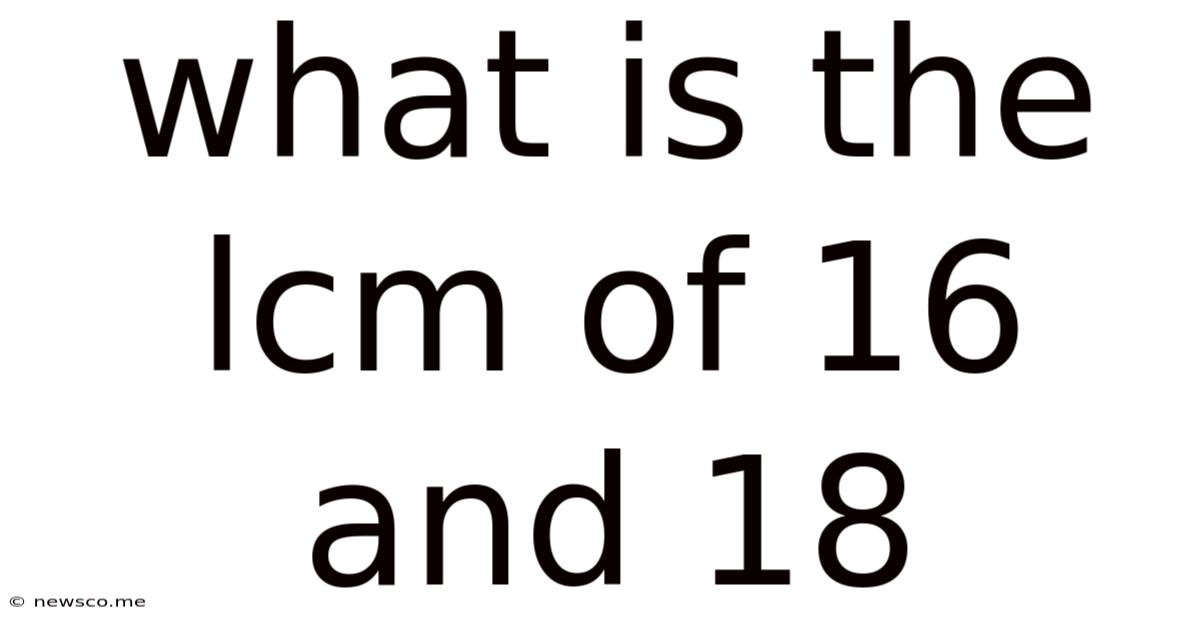What Is The Lcm Of 16 And 18
News Co
Mar 18, 2025 · 4 min read

Table of Contents
What is the LCM of 16 and 18? A Deep Dive into Least Common Multiples
Finding the least common multiple (LCM) might seem like a simple arithmetic task, but understanding the underlying concepts and various methods for calculating it opens doors to a deeper appreciation of number theory and its applications in various fields. This comprehensive guide will not only answer the question, "What is the LCM of 16 and 18?" but will also equip you with the knowledge and skills to tackle similar problems with ease and confidence. We'll explore multiple approaches, discuss their advantages and disadvantages, and highlight the importance of LCM in real-world scenarios.
Understanding Least Common Multiples (LCM)
Before we delve into calculating the LCM of 16 and 18, let's solidify our understanding of the concept. The least common multiple of two or more integers is the smallest positive integer that is divisible by all the integers without leaving a remainder. This is different from the greatest common divisor (GCD), which is the largest positive integer that divides all the integers without leaving a remainder. LCM and GCD are fundamental concepts in number theory and have numerous applications in mathematics, computer science, and even music theory.
Key Characteristics of LCM:
- Positive Integer: The LCM is always a positive integer.
- Divisibility: It's divisible by all the numbers involved.
- Smallest: It is the smallest such positive integer satisfying the divisibility condition.
Methods for Calculating LCM
Several methods exist for calculating the LCM of two or more numbers. Let's explore the most common ones, applying them to find the LCM of 16 and 18:
1. Listing Multiples Method
This is the most straightforward method, especially for smaller numbers. We list the multiples of each number until we find the smallest common multiple.
Multiples of 16: 16, 32, 48, 64, 80, 96, 112, 128, 144, ...
Multiples of 18: 18, 36, 54, 72, 90, 108, 126, 144, ...
Notice that 144 appears in both lists. Therefore, the LCM(16, 18) = 144.
Advantages: Simple and easy to understand, particularly for smaller numbers.
Disadvantages: Inefficient for larger numbers; listing multiples can become time-consuming and impractical.
2. Prime Factorization Method
This method leverages the fundamental theorem of arithmetic, which states that every integer greater than 1 can be represented uniquely as a product of prime numbers.
Prime factorization of 16: 2⁴
Prime factorization of 18: 2 × 3²
To find the LCM, we take the highest power of each prime factor present in the factorizations:
- Highest power of 2: 2⁴ = 16
- Highest power of 3: 3² = 9
LCM(16, 18) = 2⁴ × 3² = 16 × 9 = 144
Advantages: Efficient for larger numbers; avoids the lengthy process of listing multiples. It provides a systematic approach.
Disadvantages: Requires knowledge of prime factorization, which might be challenging for very large numbers.
3. Using the GCD (Greatest Common Divisor)
The LCM and GCD of two numbers are related through the following formula:
LCM(a, b) = (|a × b|) / GCD(a, b)
First, we need to find the GCD of 16 and 18. We can use the Euclidean algorithm for this:
18 = 1 × 16 + 2 16 = 8 × 2 + 0
The GCD(16, 18) = 2
Now, we can use the formula:
LCM(16, 18) = (16 × 18) / 2 = 288 / 2 = 144
Advantages: Efficient, especially when the GCD is easily found. Relates LCM and GCD, highlighting their interconnectedness.
Disadvantages: Requires knowledge of the Euclidean algorithm or another method for finding the GCD.
Applications of LCM
The concept of LCM extends far beyond simple arithmetic exercises. It has practical applications in diverse fields:
1. Scheduling and Timing Problems
Imagine two buses that depart from the same station at different intervals. One bus departs every 16 minutes, and the other departs every 18 minutes. Finding the LCM(16, 18) = 144 tells us that both buses will depart simultaneously again after 144 minutes (2 hours and 24 minutes).
2. Fraction Arithmetic
When adding or subtracting fractions with different denominators, finding the LCM of the denominators is crucial for determining the least common denominator (LCD), simplifying the process.
3. Music Theory
LCM plays a role in understanding musical intervals and harmonies.
4. Gear Ratios
In mechanical engineering, LCM helps determine gear ratios and synchronization in machinery.
5. Computer Science
LCM is used in various algorithms and data structures, particularly in scheduling and resource management.
Conclusion: The LCM of 16 and 18 is 144
We've explored multiple methods to calculate the LCM of 16 and 18, confirming that the answer is indeed 144. Understanding the different approaches allows you to choose the most efficient method based on the numbers involved. The importance of LCM extends far beyond classroom exercises, demonstrating its practical significance in various real-world applications. Mastering the concept of LCM provides a valuable tool for problem-solving across multiple disciplines. Remember to practice regularly to build your proficiency and develop a deeper understanding of this fundamental mathematical concept. By understanding the methods presented here, you are well-equipped to confidently tackle any LCM calculation and appreciate its significance in various fields.
Latest Posts
Related Post
Thank you for visiting our website which covers about What Is The Lcm Of 16 And 18 . We hope the information provided has been useful to you. Feel free to contact us if you have any questions or need further assistance. See you next time and don't miss to bookmark.